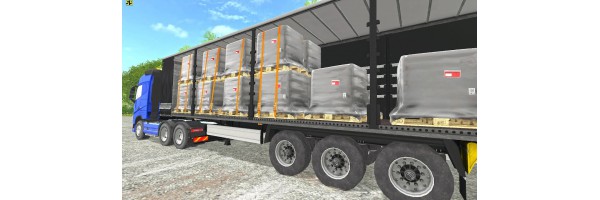
EU cargo securing law
Zeiten gelesen: 602
Failure to properly secure, securing loads in a truck causes many road accidents and fatalities every year. For this reason, the European Commission has introduced new, stricter rules regarding cargo securing. Enforcement will also be very strict. Substantial fines will follow if your load securing does not meet the minimum requirements regarding, among other things, resistance to sliding loads. These EU directives have been around longer, new is that action will be taken if the directives are not followed. Enough reason to take care of you as a user (shipper / shipper / transporter) of packaging materials. You may need to adjust the specifications of your materials such as stretch film and strapping to a higher standard / quality. VIZ packaging is happy to advise you on this.
Who bears what responsibility?
The new legislation places the responsibility on the various parties involved. For example, in addition to the carrier, you as a shipper, sender, packer or client can also be addressed today for:
incorrect packaging of the goods
incorrect use of a suitable vehicle
incorrect application of the cargo securing rules.
The clear definition of the responsibilities of the various parties in the transport chain is an important step forward!
Sender
The sender provides all necessary documents containing at least:
1. A correct description of the goods;
2. The mass of the total load;
3. All information necessary for the correct packaging;
4. The notification to the packer and / or carrier of unusual transport parameters for individual packaging.
Packer
The packer must:
1. Make a description of the goods;
2. if there is a risk that the goods will be damaged by the straps, describe an alternative method of securing the goods. If it has specific requirements for the vehicle used, these will be stated.
Shipper
The shipper ensures:
1. Distributing the load over the loading floor;
2. Loading the goods so that it is possible to use a correct fuse;
3. Respecting the maximum permissible mass (MTM) and axle loads of the vehicle;
4. The necessary information to the carrier, namely:
a. The nature of the loading unit;
b. The mass of the load and each loading unit;
c. The position of the center of gravity of each loading unit if not centered;
d. The outer dimensions of each loading unit;
e. The restrictions on stacking and the direction to be applied during transportation;
f. The friction factor of the goods, if it is not included in Annex B of EN 12195: 2010 or in the Annex of the standards IMO / UNECE / ILO;
g. All additional information required for the correct fuse.
Driver
The driver may only leave with his vehicle if he carries out the following checks:
1. Visual inspection that the rear loading doors, the folding tailgate, the doors, the covers, the spare wheel and other equipment related to the use of the vehicle are secured;
2. Check that the load does not interfere with the safe driving of the vehicle;
3. Check that the center of gravity of the load is centered as much as possible on the vehicle.
Carrier
The carrier must provide access to all relevant documentation from the shipper to the competent inspection services. Unless otherwise agreed in advance and in writing, the following conditions must be met:
1. The vehicle foreseen is suitable for the load for which it is contracted;
2. The vehicle is clean and has no structural damage;
3. The carrier attaches the container to the chassis;
4. The cargo is secured in accordance;
Different powers
The goods that are secured on the vehicle must be secured with a load securing system that can withstand certain forces. These forces arise when the vehicle undergoes the following accelerations or decelerations:
a. 0.8g in forward direction
b. 0.5g backwards
c. 0.5g sideways (on both sides)
For Wallonia and Brussels the following strength is also added:
d. 0.2g in other directions
The driver shall not depart if the load restraint system is not sufficient to withstand the above-mentioned forces exerted when the vehicle is accelerated or decelerated.
Load securing system
The legislation also clearly defines the conditions that the cargo securing systems must meet. For example, these should:
a. Functioning correctly;
b. Be suitable for the use made of it;
c. Have no knots, damaged or weakened elements that could affect its function with a view to securing the load;
d. Do not show any cracks, cuts or fraying
e. Conform to European and International product standards
VIZ packaging from Apeldoorn (NL) sells wrapping films, anti-slip sheets and strapping for perfect load securing. Specifically, take a look at the Powerstretch stretch wrapping films.

